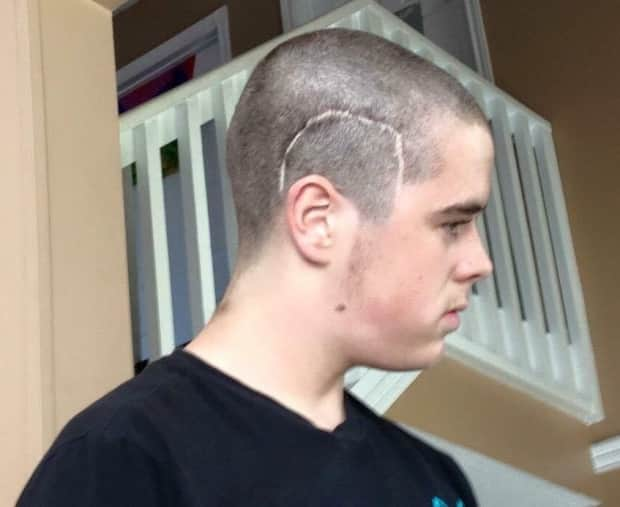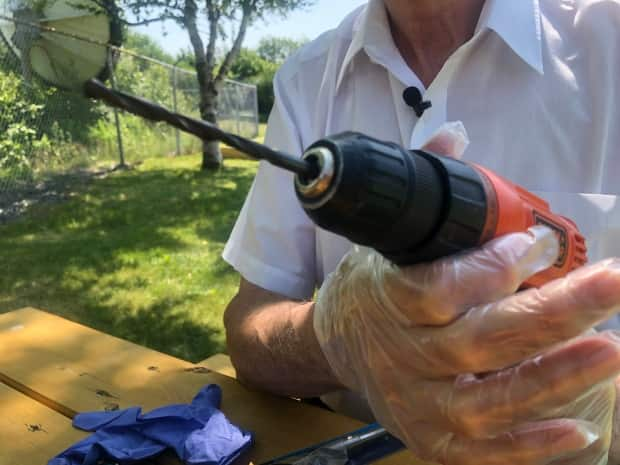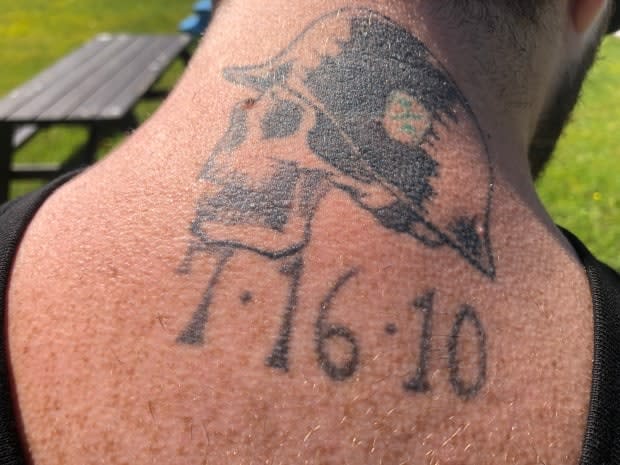How a quick-thinking doctor with a drill saved a man's life


Dr. Paul Patey knows a young man could lose his life unless he does something.
The ambulance he's in races toward St. John's, carrying a teenager who desperately needs to have blood drained from his recently injured brain.
Armed with a scalpel and a drill he borrowed from a maintenance man at the William H. Newhook Community Health Centre in Whitbourne, Patey tells the paramedic driving to find a safe spot to stop so he can try to bore a hole in the young man's skull.
"I took the drill and put it against the bone," Patey recalled.
"I took it out, and cruddy old blood started coming out like cranberry sauce."

Enjoying a warm day in a park in Marystown, Taylor Jackson, now 27, pushes his two boys, Roman, 4, and Carter, 8, on a swing set with his wife.
He sat down to share his story as a cautionary tale to the kids he's seen around town, riding on their bikes without their helmets.
"It's really not something I would wish on anybody else," he said.
On July 16, 2010, a date Jackson has tattooed on the back of his neck, the then 15-year-old hopped on to his bike without his helmet — which he says he usually wore, but not on that day — pedalling as quickly as he could to the softball field in South Dildo.
"It was a big thing, summer softball," said Jackson.
The game ended around midday, and he hopped on his bike to head home. He pushed off down a hill — and then everything came to a crashing halt.

Bombing down a dirt road hill, he isn't sure what happened, but his helmet-less head went over the handlebars and smashed into a rock.
"Everything just happened so quick," Jackson recalled. "I fractured my skull and didn't really know it."
Somehow Jackson pulled himself from the ground and, despite tremendous pain, managed to pedal to his aunt's house before his grandmother rushed him to the Whitbourne medical clinic.
"As soon as I got to my nan's house everything went black for me. I can't remember much. I was in and out of consciousness," Jackson said.
"I woke up two weeks later to find out I had brain surgery and a plate inside of my head."
On July 16, 2010, Dr. Paul Patey was just a few hours into his 24-hour locum shift at the William H. Newhook Community Health Centre.
Patey, who had officially retired a few years earlier, kept busy doing the work he loved — filling in as a family doctor in rural hospitals.
WATCH | Dr. Paul Patey and Taylor Jackson talk about the fateful moment where a life was saved in a speeding ambulance:
It's something he has done all over Newfoundland, but with Whitbourne about an hour's drive from his St. John's home, it was a favourite spot of his to fill in as locum.
A graduate of McGill medical school in the late '60s, Patey had years of rural medical practice under his stethoscope along with more than 25 years at the Health Sciences Centre and Memorial University's medical school. To keep busy he offered to fill in around the province in places that needed a short-stint doctor.
When Jackson's grandmother dropped him off at the hospital that July day, he knew right away the severity of the situation.
"I said to the nurse, 'We got a catastrophe here,'" Patey said.
At that point Jackson was still conscious, but he couldn't speak. When asked to by the doctor, he wasn't able to wiggle his toes or his fingers on one side of his body.
Patey said the young man needed a CAT scan and a team of doctors not available at the health centre in Whitbourne.
With an ambulance en route from nearby Smith's Ambulance Services, Patey made sure he had everything needed for the hour-long ride to the Janeway children's hospital in St. John's.
Wear your helmet for the love of living, not for the fear of dying - Dr. Paul Patey
He grabbed a scalpel from the medical centre and then asked a staff member to grab a drill and some bits — if things went south with Jackson, he knew, the 12-volt power drill could be the only thing aboard the ambulance to save his life.
Patey explained that the brain needs to be in a protected space — the skull — but when there is damage to the skull and it fills with blood there isn't much room left over.
"It squats the brain," said Patey. "If you squat the brain enough, you kill it."
The first thing he did was make sure the drill worked.
"There's no point in getting down the road and finding a dead battery," he said.

With a paramedic in the back joining a nurse from the Whitbourne medical centre, they put Jackson in the ambulance and floored it to St. John's.
The experienced doctor knows Jackson needs a hole bored into his brain to drain some of the blood, but the teenager is still conscious.
Patey tells the paramedic behind the wheel to get ready to stop, sanitizes the drill bit — to clean off all the drywall from the last hole it bored — and the crew of three in the back start to practise drilling.
With the nurse holding Jackson's head, Patey uses a padded head protector to ensure he doesn't drill too far into the skull.
In a twist of fate, Patey said it was just a few weeks earlier he had been showing his grandson how to drill holes through plywood cleanly to avoid making a mess in his workshop.

With Jackson's pulse dropping to 35 beats per minute, Patey starts with an incision into Jackson's scalp to get clear access to the skull, with the paramedic pulling the scalp back and the nurse holding his head in place.
A quick squeeze of the power drill's trigger — and it's done.
"We knew we had reduced the pressure. Now we had a different problem," said Patey.
"We had the bleeding in his head, but now that could get out through the hole, so the pressure wouldn't get any worse. [But] we had bleeding in his scalp because we had to make an awful big cut."
The clock was ticking to get Jackson to St. John's before he bled to death, which they did — greeted by a team from the Janeway's emergency room.
Few could have done what Patey did, says colleague
A former colleague of Patey's said there are very few doctors in the province who would have been able to do what he had done that day.
But Patey takes very little credit, offering praise instead for the paramedics and nurse from Whitbourne and talking about the speed and organization of the Janeway staff who worked on Jackson's brain before stabilizing him.
Speaking near the 12th anniversary of the accident, Jackson is filled with gratitude for everyone who helped him out. But he singles out Patey.
"I'm very thankful for that man," he said.
Patey kept the drill bit that saved Jackson's life. The doctor offered it to the teenager but Jackson declined, saying the doctor should keep it as a reminder of the incredible day when they met.
Spreading the message of helmet safety
When the weather near his home in Lewin's Cove, N.L., started to warm up last summer, Jackson noticed a lot of young folks riding around on their bicycles without wearing helmets.
Concerned with what he was seeing on the streets in his Burin Peninsula home he posted on social media a picture of a bloodied scar and a quick recap of how not wearing a helmet nearly cost him his life.
"It makes me upset just because they don't know the importance of it," Jackson said.
"Some people think it's not cool, but the scar I got on the side of my head isn't really cool either. It will just put their parents through a very bad situation I wouldn't wish on anybody."
Jackson watches his two sons run around the Burin park — two boys who have it ingrained in their heads to protect themselves with their helmets.
He doesn't feel any ill effects from what happened.
Jackson works offshore, plays hockey (he's even his team's goalie) and rides ATVs — always wearing a helmet.
He spent 35 days in hospital recovering and had to learn how to speak and walk again. When school began that September, Jackson was there.
Love of life, not fear of death
"A lot of people in these accidents, they don't get off scot-free like me," Jackson.
"Some people aren't so lucky, especially in this type of injury."
Patey also hammers home Jackson's message: helmets are necessary.
"The best reason for putting a helmet on is because you want to live a long, happy life," said Patey.
"Look at Taylor. He's got 12 more years of good living done since he had a hole in his head. People who put their helmet on now can have 12 years of living with less chance of putting a hole in their head.
"So wear your helmet for the love of living, not for the fear of dying."

